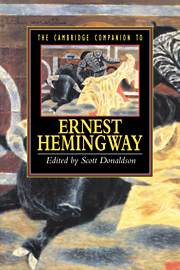Book contents
- Frontmatter
- 1 Introduction
- 2 Hemingway's journalism and the realist dilemma
- 3 1924
- 4 In Our Time, out of season
- 5 Brett and the other women in The Sun Also Rises
- 6 A Farewell to Arms
- 7 Hemingway's late fiction
- 8 Hemingway and politics
- 9 Hemingway and gender history
- 10 Hemingway, Hadley, and Paris
- 11 Hemingway's Spanish sensibility
- 12 The Cuban context of The Old Man and the Sea
- 13 Conclusion
- Selected Bibliography
- Index
- Series List
9 - Hemingway and gender history
Published online by Cambridge University Press: 28 May 2006
- Frontmatter
- 1 Introduction
- 2 Hemingway's journalism and the realist dilemma
- 3 1924
- 4 In Our Time, out of season
- 5 Brett and the other women in The Sun Also Rises
- 6 A Farewell to Arms
- 7 Hemingway's late fiction
- 8 Hemingway and politics
- 9 Hemingway and gender history
- 10 Hemingway, Hadley, and Paris
- 11 Hemingway's Spanish sensibility
- 12 The Cuban context of The Old Man and the Sea
- 13 Conclusion
- Selected Bibliography
- Index
- Series List
Summary
In a letter written to Charles Scribner in 1949, Ernest Hemingway listed “Mr. Turgenieff” and “Mr. Maupassant” as authors he had beaten in the ring. Among his prospective opponents were “Mr. Henry James,” “Mr. Cervantes,” and the redoubtable “Dr. Tolstoi.” Finally, he mentioned “some guys nobody could ever beat like Mr. Shakespeare (The Champion) and Mr. Anonymous” (SL 673). In the notorious 1950 Lillian Ross interview published in The New Yorker, Hemingway, with the same self-conscious braggadocio, repeated this list of authors and declared himself literary heavyweight champion, having won the title in the 1920s and defended it ever since (Ross 49).
Hemingway's boxing metaphor and the male opponents (emphasized by the masculine forms of address) neatly convey his belief - this was before the discovery that Anonymous was a woman - that the world of writing should be a man's world, a boxing gym, no women allowed. And truly, his New Yorker performance and other, even less subtle, public displays have made “Papa Hemingway” synonymous with a stereotypical notion of masculinity. It is a standard rule of reading imaginative literature that one should distinguish between an author's actual life and the lives that appear in his or her fiction, but for many readers - especially women - Hemingway's fame as a man makes this rule hard to observe (Abbott 612). The accusation of male chauvinism hangs over the man and his work.
- Type
- Chapter
- Information
- The Cambridge Companion to Hemingway , pp. 170 - 196Publisher: Cambridge University PressPrint publication year: 1996
- 5
- Cited by

